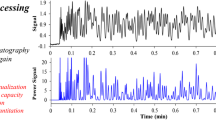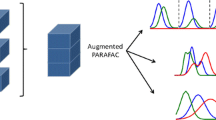Abstract
This paper describes an alternative algorithm for a simultaneous multicomponent analysis with three-mode three-dimensional array data generated by liquid chromatography with diode array detection (LC-DAD). The algorithm is mainly based on a combination of two-step Moore-Penrose pseudoinverse computations based on a truncated singular value decomposition (TSVD) and one-step direct bilinear decomposition. It is modeled with a series of pure or mixed reference samples and then used to analyze several unknown samples. The algorithm was evaluated by Monte-Carlo simulations of two synthetic LC-DAD data sets with different noise levels, and applied to the simultaneous determination of chlorobenzene and toluene by means of HPLC with a photodiode array detector. The obtained results show that the proposed algorithm is suitable for simultaneous determinations of several components, of which the chromatographic peaks and absorption spectra heavily overlap each other, provided that their three-dimensional data have trihnear properties.
Similar content being viewed by others
Abbreviations
- ‖ ‖:
-
the Frobenius or Euclidian norm
- m:
-
a running index for counting reference or standard samples (objects)
- M:
-
the number of the reference samples
- h:
-
a running index for counting selected wavelengths (channels)
- H:
-
the number of selected wavelengths (channels)
- k:
-
a running index for counting selected elution time positions occasions)
- K:
-
the number of selected elution time positions (occasions)
- l:
-
a running index for counting unknown samples
- L:
-
the number of unknown samples
- n:
-
a running index for counting chemical components of interest
- N:
-
the number of chemical components of interest
- Rs :
-
a three-dimensional response array from M pure or mixture reference samples with a two-dimensional response matrix for each sample (size M*H*K)
- Ru :
-
a three-dimensional response array from L unknown samples (size L*H*K)
- r mkk :
-
the element of Rs, the response of the mth reference sample on the hth wavelength at the kth elution time position
- r lhk :
-
the element of Ru, the response of the lth unknown sample on the hth wavelength at the kth elution time position
- Rsh:
-
the kth slice of Rs (size M* H)
- Ruk:
-
the kth slice of Ru (size L*H)
- Cs:
-
a concentration matrix composed of M reference samples (size M*N)
- cmn:
-
the element of Cs, the concentration of the nth chemical component in the mth reference sample
- Cu:
-
a concentration matrix composed of L unknown samples (size L*N)
- cln:
-
the element of Cu, the estimated concentration of the nth chemical component in the lth unknown sample
- cln*:
-
the theorical concentration of the nth chemical component in the lth unknown sample
- cn:
-
the nth column of Cs or Cu, corresponding to the nth chemical component of interest (size M*1 or L*1)
- S:
-
a sensitivity coefficient matrix for N chemical components of interest (size H*N)
- s n :
-
the nth column of S, corresponding to the nth chemical component of interest (size H*1)
- shn:
-
the element of S, the sensitivity coefficient of the nth chemical component on the hth wavelength
- T:
-
a dimensionless time profile matrix of N chemical components of interest (size K*N)
- T:
-
a three-dimensional array of size N*N*K in which the diagonal of the kth slice, Tk, is the kth row of T
- T k :
-
the kth diagonal matrix of T, whose elements are the kth row of T (size N*N)
- t n :
-
the nth column of T, corresponding to the nth chemical component of interest (size K*1)
- tkn:
-
the element of T
- I :
-
a 3-dimensional superdiagonal array with ones on the superdiagonal and zeros elsewhere (size N*N*N)
- E :
-
a three-dimensional residual array for M reference samples in calibration stage (size M*H*K)
- E k :
-
the kth slice of E (size M* H)
- emhk:
-
the element of E
- F :
-
a three-dimensional residual array for L unknown samples in prediction stage (size L*H*K)
- F k :
-
the kth slice of F (size L*H)
- fmhk:
-
the element of F
- +:
-
a notation denoting the Moore-Penrose pseudoinverse
- ′:
-
a notation denoting the transpose of a matrix
- D :
-
a three-dimensional array with Dk=(Cs)+Rsk for k=1,...,K(size N*H*K
- D k :
-
the kth slice of D (size N* H)
- dnhk:
-
the element of D
- tmax(n):
-
the maximum value in T corresponding to the nth chemical component
- TN(n):
-
the elution time position corresponding to the tmax(n)
- A :
-
a three-dimensional array with Ak=Ruk(Sr)+ for k=1,..., K (size L*N*K)
- A k :
-
the kth slice of A (size L*N)
- alnk:
-
the element of A
- qa:
-
selected integer used for averaging of shn and cln, depending on the selected elution time interval along the time axis
- z:
-
a relative standard deviation relative to the maximum response value of Rs or Ru as a noise level coefficient used in Monte-Carlo simulation
References
T. Hirschfeld, Anal. Chem., 52, 297A (1980).
K. S. Booksh and B. R. Kowalski, Anal. Chem., 66, 782A (1994).
P. Geladi, Chemom. Intell. Lab. Syst., 7, 11 (1989).
A. K. Smilde, Chemom. bitell Lab. Syst., 15, 143 (1992).
E. Sanchez and B. R. Kowalski, Anal. Chem., 58, 496 (1986).
B. Wilson, E. Sanchez, and B. R. Kowalski, J. Chemom., 3, 493 (1989).
R. A. Harshman and M. E. Lundy, Computational Statistics & Data Analysis, 18, 15 (1994).
S. Wold, P. Geladi, K. Esbensen and J. Ohman, J. Chemom., 1, 41 (1987).
J. Ohman, P. Geladi, and S. Wold, J. Chemom., 4, 135 (1990).
A. K. Smilde and D. A. Doornbos, J. Chemom., 6, 11 (1992).
E. Sanchez and B. R. Kowalski, J. Chemom., 4, 29 (1990).
K. S. Booksh, Z. Lin, Z. Wang and B. R. Kowalski, Anal. Chem., 66, 2561 (1994).
A. K. Smilde, Y. Wang, and B. R. Kowalski, J. Chemom., 8, 21 (1994).
A. K. Smilde, R. Tauler, J. M. Henshaw, L. W. Burgess and B. R. Kowalski, Anal. Chem., 66, 3345 (1994).
E. Sanchez and B. R. Kowalski, J. Chemom., 2, 265 (1988).
S. Li and P. Gemperline, J. Chemom., 7, 77 (1993).
T. Hoshino, M. Senda, T. Hondo, M. Saito and S. Tohei, J. Chromatogr., 316, 473 (1984).
T. Hoshino, T. Hondo, M. Senda, M. Saito and S. Tohei, J. Chromatogr., 332, 139 (1985).
E. R. Malinowski, “Factor Analysis in Chemistry”, 2nd ed., John Wiley & Sons, Inc., New York, 1991.
D. S. Burdick, X. M. Tu, L. B. McGown and D. W. Millican, J. Chemom., 4, 15 (1990).
S. Leurgans and R. T. Ross, Statistical Science, 7, 289 (1992).
R. A. Harshman, UCLA Working Papers in Phonetics, 16, 1 (1970).
J. D. Carroll and J. Chang, Psychometrika, 35, 283 (1970).
H. Law, C. Snyder, Jr., J. Hattie and R. McDonald (ed.), “Research Methods for Multimode Data Analysis”, Praeger, New York, 1984.
R. Coppi and S. Bolasco (ed.), “Multiway Data Analysis”, Elsevier Science Publishers B.V., North-Holland, 1989.
J. B. Kruskal, Linear Algebra Appl., 18, 95 (1977).
L. R. Tucker, Psychometrika, 31, 279 (1966).
P. M. Kroonenberg, “Three-Mode Principal Component Analysis”, DSMO Press, Leiden, 1983.
H. Martens and T. Næs, “Multivariate Calibration”, Wiley, New York, 1989.
G. Golub and C. Vanloan, “Matrix Computations”, 2nd ed., The John Hopkins University Press, Baltimore, 1989.
H.-L. Wu, K. Oguma, and R.-Q. Yu, Anal. Sci., 10, 875 (1994).
C. L. Lawson and R. J. Hanson, “Solving Least Squares Problems”, Prentice-Hall, Englewood Cliffs, 1974.
R. I. Shrager, Chemom. Intell. Lab. Syst., 1, 59 (1986).
G. J. Hahn and S. S. Shapiro, “Statistical Models in Engineering”, Section 7-3, John Wiley and Sons, New York, 1967.
L. M. Schwartz, Anal. Chem., 47, 963 (1975).
J. W. Harbaugh and G. Bonham-Carter, “Computer Simulation in Geology”, R. E. Krieger Pub. Co., Malabar, 1981.
H. R. Keller and D. L. Massart, Anal. Chim. Acta, 246, 379 (1991).
Author information
Authors and Affiliations
Rights and permissions
About this article
Cite this article
Wu, HL., Feng, YQ., Shibukawa, M. et al. Alternative Algorithm for Simultaneous Determinations of Components Poorly Resolved by Liquid Chromatography with Multiwavelength Detection. ANAL. SCI. 13, 99–108 (1997). https://doi.org/10.2116/analsci.13.99
Received:
Accepted:
Published:
Issue Date:
DOI: https://doi.org/10.2116/analsci.13.99




